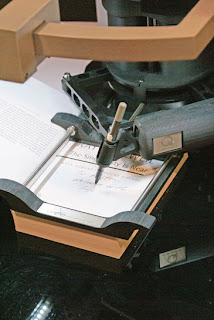 In a few hours Margret Atwood and company will unleash LongPen on the BEA. From London to Walla Walla authors will be signing books for BEA attendees from the comfort of their own home (or publishers office).
In a few hours Margret Atwood and company will unleash LongPen on the BEA. From London to Walla Walla authors will be signing books for BEA attendees from the comfort of their own home (or publishers office).
It is billed as “the world’s first real time, pen and ink long-distance autographing device” which produces “legally valid” signatures.
LongPen is the next generation of the Autopen, a technology first invented in 1803 (it was called a polygraph) and was used extensively by Thomas Jefferson.
These days it is a required technology for many politicians, celebrities and sports stars who simply cannot personally keep up with the demand or need for their signature. Ex Secretary of Defense Donald Rumsfeld was caught using the autopen technology to sign letters to the families of people killed in Iraq.
LongPen takes the technology of the Autopen and brings it into the 21st century by adding an audio and video component to the experience and by operating in real time.
LongPen is also being hailed as an ultimate green technology by eliminating the need for travel and its associated costs. The authors who will demonstrate the LongPen at the BEA will be saving over 5 tons of carbon emissions by signing via LongPen instead of taking taking airplanes to appear in person. Can’t argue with that.
There are still many questions.
How will the bookselling markets react? Will books signed using this technology need to be labeled as such. Will we begin to see catalog descriptions like “Signed via LongPen”, “Inscribed via LongPen” or “Signed in Person” etc. Will they have comparable value in the marketplace?
No matter how green an experience it is it still presents a fundamental shift in what a “reading” is. When the novelty wears off in a few years will it survive? Standing in line to get your book signed by a machine while you get a minute or so of face time with the author via video conferencing is quite a leap from the current schema of readings. Can you replace the lost intimacy through technology?
The reading series of many an independent bookstore is just a shell of what it once was in the pre-Amazon days. I look at the Elliott Bay Book Company here in Seattle whose reading series run by Rick Simonson was one of the strongest in the country. Now one only needs to look at the size of their printed reading schedule to know things have changed drastically.
Can this technology revitalize these reading series? Can we fill in those dark nights with content from around the world?
What about the cost? Since the program is still in its pilot phase the cost for booksellers has yet to be determined. For publishers the cost is $800 per event with a $1250 connectivity charge. I suspect like most emerging technologies the cost will be prohibitive for most independent bookstores early on though I have heard there will be a leasing option.
One concern is that by the time it becomes affordable for the small independent bookstore it will have been in every store of the big box retailers for some time. What happens then?
I can’t wait to see how this one plays out.
Click here to watch the LongPen in action
Is It Real? has tons of examples of autopen signatures
Signascript produces traditional autopen or “signing” machines
BookTwo has some other ideas for new kinds of readings
